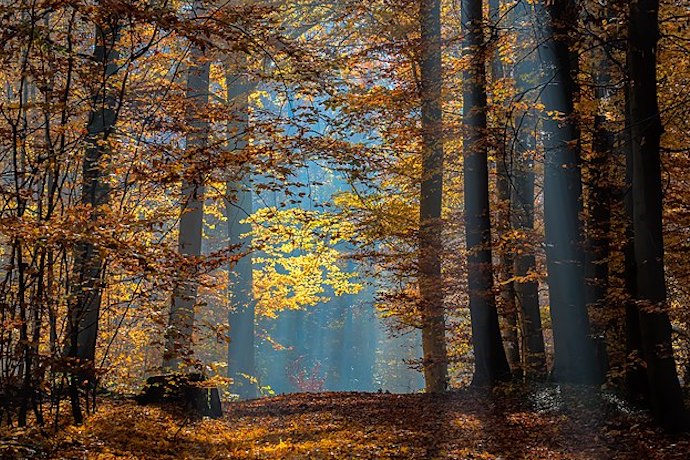By Ethan Borshansky
As sweater weather turns to jacket weather, we can all use a fresh variety of classical music inspired by autumn. Here is a list of some slightly more obscure contemporary and classical works inspired by the most colourful season.
1. Michael Torke: October
For those seeking a vigorous, pulsating classical soundtrack for those Sunday errands, Michael Torke’s October will likely provide nicely. The piece of classical music inspired by autumn is scored for string quartet and bass clarinet, making for a glorious timbral range to capture ‘the frisson of decay’ as the composer describes it. Torke has been one of most commercially successful classical composers in the last twenty years with his electric, iterative style. Groovier and more contrapuntally dazzling than adjacent styles of ‘American minimalism’, October is a delightful hybrid of Philip Glass and Prokofiev.
- Read: classical music inspired by folksongs | 5 of the best
- Read: Profile of the Vegetable Orchestra | the troupe that carves instruments out of fresh produce
2. Max Richter: Recomposed by Max Richter: Vivaldi – The Four Seasons
German-British composer Max Richter has been something of a household name composer over the past decade, largely because of this very work. Recomposed by Max Richter: Vivaldi – The Four Seasons is a masterclass in ‘remix’ composition. Vivaldi is identifiable throughout ‘Autumn’, but the modern composer takes clever liberties with the original, first through subtle metric hiccups and then opening up to an atmospheric free-form suite of his cinematic, warm and personal aesthetic. The Deutsche Grammophon recording is gorgeous, and Daniel Hope’s sensitive virtuosity shines in all four seasons if you happen to lose yourself in the piece.
- Read: Review of Recomposed by Max Richter: Vivaldi – The Four Seasons
- Read: classical music inspired by the sea | 5 of the best pieces
3. Michael Gordon: Weather One
Next on our list of classical music inspired by autumn: although not explicitly so, Michael Gordon’s stormy Weather is clearly in the tradition of the four-part collection of string compositions meant to evoke the seasons. All four movements are rhythmic, while also melancholy and slightly haunting, often resembling the cold and cavernous Venetian church of Vivaldi’s world. The movements are also named ambiguously by season number, so have your pick as to which captures autumnal moods most appropriately for you. The first movement is hard to beat with its playful syncopation, driving spiccato bass lines, and occasional light brush strokes of electronica in the background.
4. Joseph Haydn: The Seasons (Die Jahrenszeiten)
Known primarily for his titanic output of symphonies and chamber works, Haydn’s contribution to the season genre is an often-overlooked masterpiece in text painting. The Seasons (1801) is a surprisingly hefty oratorio, even in the wake of his more religious The Creation (1798). Seen as old-fashioned at the time for its use of a translated 1730s English text (by James Thompson), The Seasons is actually quite modern in its grand secularity and anticipation of the pastoral landscapes that would become central to the German romantic-era composers. Enjoy the elegance of Haydn’s late Esterházy style on a walk in cozy sweater style.
5. Toru Takemitsu: Autumn
The Japanese composer, Toru Takemitsu, had a long-running penchant for nature- inspired soundscapes, first in orchestral works such as Music of Trees (1961) and November Steps (1967). Building on the latter, Takemitsu implemented his favoured configuration of orchestra plus shakuhachi and biwa (traditional Japanese instruments) in Autumn (1973) to depict a dreamy, windy panorama. The work of a studied orchestrator, Autumn channels much of Debussy’s colouristic craft, only in subtler tones and in more meditative form. Of all the pieces of classical music inspired by autumn, maybe this one is not the ideal choice for jogging, but lovely for an attentive listen over a morning coffee.
